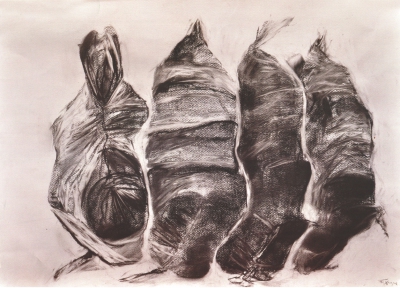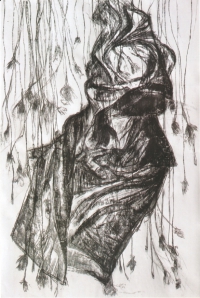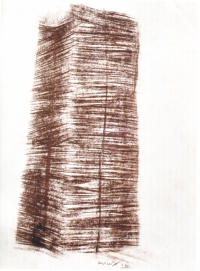| Home - Back Issues - The Team - Contact Us |
 |
| Volume 12 |Issue 02| January 11, 2013 | |
|
|
Art A Conversation about Art Fayza Haq
A teacher, originally from Chandpur, now teaching fine arts at the Chittagong University , Dhali Al Mamun is soft-spoken and is an image of gentleness with his waving greying hair and tortoise shelled specs. Yet he is very clear about how he views life and art. According to Dhali, a true artist tries to unfold what he feels and sees. He tries to communicate with others and also portray what he imagines. Contemporary art has changed from previous ideas and paradigms. The notion of aesthetics too has changed. Contemporary art has taken a lot from the knowledge of the mind—a whole lot of thinking process goes in. Nietzsche and Freud have inspired many artists. Through art you can create a discourse. What you see brings in the anthropological object; it includes items from biology and botany: even history and geography. Various ingredients get into making contemporary art. Talking about installation, Dhali says, that talking of artists who are inclined to follow the other path , and depict the unconventional. This follows conceptual art. Here he again touches an paradigms. Van Gogh and Matisse painted with their heart and soul. Van Gogh brought in the dry grass, the Cyprus trees and the gold disc of the sun that radiated the heat. Matisse, similarly, brought in all aspects of the natives he lived with in the islands. They did not worry so much about the result and the remuneration for the art work. “Of course an artist needs the money, – he/she has to live and eat, says Dhali. However he thinks that the galleries nowadays dictate too much. Artists are asked to paint work that will sell. Dhali says “The art market is controlled by the triple C: curator , critique and the collector. This is a kind of guild of the Middle Ages or Mafia of the present time. The gallery in our country is still in a primitive form because the collectors and our economy do not help the artist. Van Gogh and Matisse were emotionally and instinctively charged. Nowadays the retina is not enough. One has to incorporate through the cerebra. A Greek philosopher has said that the artist does not copy nature. One's knowledge is developed through one's emotions, perceptions. It is a kind of chemistry." What if the viewer cannot pick up the harmony of the picture before him—if the abstraction created is beyond his comprehension? To this Dhali says, "If we trace the journey of art from the cave paintings to the two dimensional surface, we find that the creative process has changed. Impressionism , for instance, is a different kind of paradigm. They the Impressions were first people who changed the notion of the modern era. Renoir, Monet, Matisse and Cezanne. Earlier the artist made their layout and knew their destination
The Impressionists did not know where to stop. This was because of the society of the times in France, 21st century brought in the exploration by the artists of the thought process of the whole world. Asked which of the French Impressionists did the artist like most he says, “I like them all as they changed the whole aspect of painting. They changed the thought process of the artists”. What about the galleries in Dhaka, are they catering to the interests of the artists? "The cultural happenings are important for our society" says Dhali. "In Dhaka there are around two crore people, but how many art galleries do we have in the capital? I feel that in terms of the population, there should be a hundred galleries, but this is not so." The galleries focus on both the traditional and contemporary art. We must think in our own context and not just worry about Europe's output” Speaking about the War of Liberation in '71, Dhali says, at that time he was about 12 or 13 years old. "I saw the violence and tremendous brutality.” The lake where he gathered “shapla” flowers, carried beheaded and mutilated corpses. This naturally influenced the artist's aesthetics the contrast of beauty and brutality shocked him. He fled to his Chandpur village homestead, running away from Comilla. His recent exhibition in the Bengal Art Lounge , in Gulshan. was based on the genocide of '71. “I explored the villages. Even the Muslims were massacred, along with women and children; the plan was to eliminate the intelligentia of East Pakistan. Many film-makers, dramatists, poets, doctors, university teachers , and thinkers were blacklisted – tortured and finally killed brutally. Lakhs of people had to flee their burning or broken homes." The artist is inspired by what he sees around him. He is egged on and encouraged by it. Did he happen to portray Nature –the rivers, flowers, trees, the farmers, fishermen and other common daily workers ? The artist says socio-economic and political happenings may inspire a painter while the calm, beautiful nature in repose, another painter. Inspiration, just as style and theme, differ from one artist to another. Many things like the crack of dawn may lead one to paint and sketch. For the post-modern artist, the object of the flora and fauna have been replaced. The object is important for culture and civilisation to flourish. There are many object, hand-made, industrial and that taken from Nature. In the city, how many people can enjoy the gifts of nature? There is so little greenery, the limitation of open spaces and occurrences of waterways in the form of pond or river or even rivulets. Would one say that art education in Dhaka is different today from what it was when actual rivers and butcher's shops were visited and sketched and painted—rather that studying things from photographs – as is done in some art classes? Dhali says "The agricultural object or the fish which, David Hockney, the Renaissance master painters used the camera obscura. What is important—the product or the process?” Talking about paintings, which have been done on the computer—and yet has gained popularity, the teacher, painter comments, "I think it is OK. Computerised painting as done by Maksud, and Ahmed Nazir should be accepted in our post-modern days."
Copyright
(R) thedailystar.net 2013 |
||||||||||||||||



